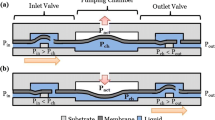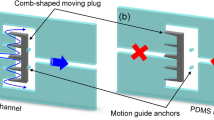Abstract
Inspired by the feeding mechanisms of a nematode, a novel two-indenter (2I) micro-pump is analyzed theoretically for transport and mixing of a non-Newtonian fluid for the purpose of lab-on-a-chip applications. Considering that the viscous forces dominate the flows in microscopic regime, the concept lubrication theory was adopted to device the two-dimensional flow model of the problem. By approximating the movements of the indenter as a sinusoidal function, the details of the flow were investigated for variations in—frequency of contraction of the first value keeping the second valve at higher occlusion, and occlusion. The study indicates that occlusive nature of the second valve leads to the large pressure barrier which prevents the fluid to enter into the neighboring compartment. Transport occurs as the lumen opens to develop a suction pressure. Pressure barrier is found to be highest for dilatants followed by Newtonian and pseudo-plastics. Shear stress dependency on frequency the contraction of the first value is highest for lower values of flow behavior index. In conclusion, the study provides details connecting the flows resulting from the indentation of the front-end indenter to the frequency of indentation, geometry and rheology of the fluid, thus facilitating optimal design of the micro-pumps.












Similar content being viewed by others
Abbreviations
- C. elegans :
-
Caenorhabditis elegans
- MDDS:
-
Micro drug delivery system
- µTAS:
-
Micro total analysis systems
- POC:
-
Point of care
- PCR:
-
Polymerase chain reaction
- t:
-
Time
- r:
-
Radial coordinate
- θ:
-
Aximuthal coordinate
- z:
-
Axial coordinate
- c:
-
Velocity scale
- f:
-
Frequency of closure/opening of the 1st valve
- z0 :
-
Reference axial position of the 1st valve
- z0’:
-
Reference axial position of the 2nd valve
- a:
-
max. radius of the cylinder
- λ:
-
Wavelength of the 1st valve
- λ’:
-
Wavelength of the 2nd valve
- R:
-
Shape function of cylinder indicating radius
- pocc,max :
-
max. occlusion of the valves
- pocc :
-
Occlusion of the 1st valve at time ‘t’
- pocc’ :
-
Occlusion of the 2nd valve at time ‘t’
- ur :
-
Radial velocity
- uθ :
-
Velocity along th-direction
- uz :
-
Axial velocity
- Ur,B :
-
Radial velocity of the wall
- m:
-
Flow consistency index
- n:
-
Flow behavior index
- µ:
-
Viscosity of the fluid
- P:
-
Pressure
- τ:
-
Wall shear stress
- Q:
-
Flow rate
- *:
-
Indicates dimensional variable
References
Woias P (2005) Micropumps—past, progress and future prospects. Sens Actuators, B 105:28–38
Laser DJ, Santiago JG (2004) A review of micropumps. J Micromech Microeng 14:R35–R64
Au AK et al (2011) Microvalves and micropumps for BioMEMS. Micromachines 2(2):179–220
Figeys D, Pinto D (2000) Lab-on-a-chip: a revolution in biological and medical sciences. Anal Chem 72(9):330A–335A
Haeberle S, Zengerle R (2007) Microfluidic platforms for lab-on-a-chip applications. Lab Chip 7(9):1094–1110
Vilkner T, Janasek D, Manz A (2004) Micro total analysis systems. Recent developments. Anal Chem 76(12):3373–3385
Jung W et al (2015) Point-of-care testing (POCT) diagnostic systems using microfluidic lab-on-a-chip technologies. Microelectron Eng 132:46–57
Cui P, Wang S (2018) Application of microfluidic chip technology in pharmaceutical analysis: a review. J Pharm Anal 9:238–247
Auroux PA et al (2002) Micro total analysis systems. 2. Analytical standard operations and applications. Anal Chem 74(12):2637–2652
Reyes DR et al (2002) Micro total analysis systems. 1. Introduction, theory, and technology. Anal Chem 74(12):2623–2636
Yu F, Choudhury D (2019) Microfluidic bioprinting for organ-on-a-chip models. Drug Discov Today 24(6):1248–1257
Bein A et al (2018) Microfluidic organ-on-a-chip models of human intestine. Cell Mol Gastroenterol Hepatol 5(4):659–668
Gerasimenko TN et al (2017) Modelling and characterization of a pneumatically actuated peristaltic micropump. Appl Math Model 52:590–602
ChanJeong O, Konishi S (2007) Fabrication and drive test of pneumatic PDMS micro pump. Sens Actuators, A 135(2):849–856
Huang C-W, Huang S-B, Lee G-B (2006) Pneumatic micropumps with serially connected actuation chambers. J Micromech Microeng 16(11):2265–2272
Lee I et al (2016) Four-electrode micropump with peristaltic motion. Sens Actuators, A 245(1):19–25
Uhlig S et al (2018) Electrostatically driven in-plane silicon micropump for modular configuration. Micromachines 9(4):1–15
Said MM et al (2017) Hybrid polymer composite membrane for an electromagnetic (EM) valveless micropump. J Micromech Microeng 27(7):1–8
Said MM et al (2018) The design, fabrication, and testing of an electromagnetic micropump with a matrix-patterned magnetic polymer composite actuator membrane. Micromachines 9(1):1–10
Chen S et al (2016) A normally-closed piezoelectric micro-valve with flexible stopper. AIP Adv 6:045112–045119
Shabanian A et al (2016) A novel piezo actuated high stroke membrane for micropumps. Microelectron Eng 158(1):26–29
Yamahata C et al (2005) A PMMA valveless micropump using electromagnetic actuation. Microfluid Nanofluidics 1(3):197–207
Avvari RK (2019) Biomechanics of the small intestinal contractions. In: Qi DX (ed) Management of digestive disorders. Intech Open, London
Avvari RK (2019) Effect of local longitudinal shortening on the transport of luminal contents through small intestine. Acta Mech Sin 35(1):45–60
Avvari RK (2015) Bio-mechanics of the distal stomach and duodenum: an insight into mechanisms of duodenogastric reflux and duodenal mixing. In: Department of biological sciences and bioengineering. 2015, 48th Graduating Students Convocation, Indian Institute of Technology Kanpur
Smits JG (1990) Piezoelectric micropump with three valves working peristaltically. Sens Actuators A Phys 21(1):203–206
Cao L, Mantell S, Polla D (2001) Design and simulation of an implantable medical drug delivery system using microelectromechanical systems technology. Sens Actuators A Phys 94(1):117–125
Bu M et al (2003) Design and theoretical evaluation of a novel microfluidic device to be used for PCR. J Micromech Microeng 13(4):S125–S130
Husband B et al (2004) Novel actuation of an integrated peristaltic micropump. Microelectron Eng 74(1):858–863
Berg JM et al (2003) A two-stage discrete peristaltic micropump. Sens Actuators, A 104(1):6–10
Shapiro AH, Jaffrin MY, Weinberg SL (1969) Peristaltic pumping with long wavelengths at low Reynolds number. J Fluid Mech 37(4):799–825
Misra JC, Maiti S (2011) Peristaltic transport of a rheological fluid: model for movement of food bolus through esophagus. Appl Math Mech 33(3):315–332
Avvari RK (2020) Theoretical modeling of the resistance to gastric emptying and duodenogastric reflux due to pyloric motility alone, presuming antral and duodenal quiescence. J Theor Biol 508:1–16
Avery L, You YJ (2012) C. elegans feeding. WormBook, Hoboken, pp 1–23
Fang-Yen C, Avery L, Samuel AD (2009) Two size-selective mechanisms specifically trap bacteria-sized food particles in Caenorhabditis elegans. Proc Natl Acad Sci 106(47):20093–20096
Avery L, Shtonda BB (2003) Food transport in the C. elegans pharynx. J Exp Biol 206:2441–2457
Kwiatek MA et al (2006) Quantification of distal antral contractile motility in healthy human stomach with magnetic resonance imaging. J Magn Reson Imaging 24(5):1101–1109
Tanaka Y et al (2012) Mechanics of peristaltic locomotion and role of anchoring. J R Soc Interface 9(67):222–233
Brackenbury J (1999) Fast locomotion in caterpillars. J Insect Physiol 45(6):525–533
Li M, Brasseur JG (1993) Non-steady peristaltic transport in finite-length tubes. J Fluid Mech 248:129–151
Pal A et al (2004) Gastric flow and mixing studied using computer simulation. Proc Biol Sci 271(1557):2587–2594
Misra JC, Pandey SK (2001) A mathematical model for oesophageal swallowing of a food-bolus. Math Comput Model 33:997–1009
Misra JC, Maiti S (2012) Peristaltic transport of rheological fluid: model for movement of food bolus through esophagus. Appl Math Mech 33(3):315–332
Ravi Kant A, Pal A (2011) Intestinal transport and mixing analyzed using computer simulations. In: 1st Biennial meeting of Indian motility and functional diseases association (IMFDA). SGPGIMS, Lucknow
Weinberg SL, Ecksein EC, Shapiro AH (1971) An experimental study of peristaltic pumping. J Fluid Mech 49:461–479
Latham TW (1966) Fluid motions in a peristaltic pump. Massachusetts Institute of Technology, Cambridge
Suzuki Y et al (2019) Particle selectivity of filtering by C. elegans. Theor Appl Mech Lett 9(2):61–65
Fueser H et al (2019) Ingestion of microplastics by nematodes depends on feeding strategy and buccal cavity size. Environ Pollut 255(Pt 2):113227
Salafi T, Zeming KK, Zhang Y (2016) Advancements in microfluidics for nanoparticle separation. Lab Chip 17(1):11–33
Fakour M et al (2015) Analytical study of micropolar fluid flow and heat transfer in a channel with permeable walls. J Mol Liq 204:198–204
Acknowledgements
The author received no financial support for the research, and/or publication of this article. For the purpose of the study, author has used computational resources (with Matlab licence) at the institute facility.
Author information
Authors and Affiliations
Corresponding author
Ethics declarations
Conflict interest
The author declared no potential conflicts of interest with respect to the research, authorship, and/or publication of this article.
Additional information
Publisher's Note
Springer Nature remains neutral with regard to jurisdictional claims in published maps and institutional affiliations.
Rights and permissions
About this article
Cite this article
Avvari, R.K. A novel two-indenter based micro-pump for lab-on-a-chip application: modeling and characterizing flows for a non-Newtonian fluid. Meccanica 56, 569–583 (2021). https://doi.org/10.1007/s11012-020-01303-1
Received:
Accepted:
Published:
Issue Date:
DOI: https://doi.org/10.1007/s11012-020-01303-1




